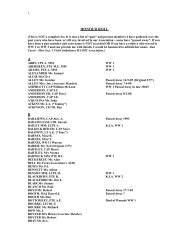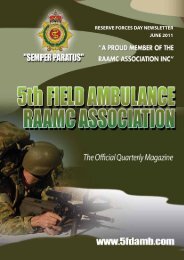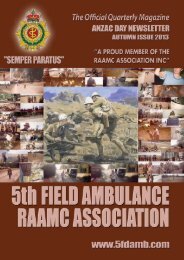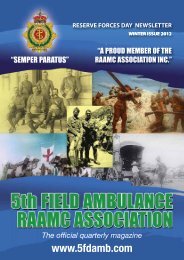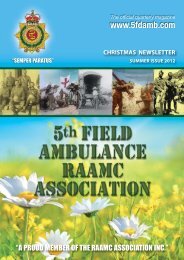2010 Paulatim Magazine - RAAMC Association
2010 Paulatim Magazine - RAAMC Association
2010 Paulatim Magazine - RAAMC Association
You also want an ePaper? Increase the reach of your titles
YUMPU automatically turns print PDFs into web optimized ePapers that Google loves.
a. rebalanced deployable AAPsych capability to allow the optimal<br />
task-specific Psychology Support Teams (PsST) through<br />
augmentation of CHSB and GHSB;<br />
b. centralised management of all operational mental health capability<br />
within RTS and augmentation of the GHS Mental Health and<br />
Psychology Sections as endorsed under RLA with JHC;<br />
c. dedicated specialist capability development and operational<br />
analysis; and<br />
d. standardisation of MST for all deployable PsST.<br />
Garrison Health Support. The CHS restructure will facilitate the<br />
GHS transition and enable JHC to deliver comprehensive GHS. This will<br />
incorporate augmentation through the RTS cycles, maintenance of<br />
habitual relationships between close health elements and bde elements<br />
they predominately support, enable the establishment of Army clinical<br />
governance regimes of GHS models of care, enable the establishment<br />
of bde level welfare boards/injured personnel management cells and<br />
support soldier rehabilitation and transition.<br />
ARES Combat Health Capability. The ARES is a key Combat Health<br />
enabler and integrated into a number of the CHS structures to provide<br />
a whole of force package. The 3 HTRB will manage the personnel that<br />
generate the ‘high end’ clinical ARES capability for the Army.<br />
The development of the ARES health capability (outside 3 HTRB) will<br />
be informed by the ARA CHS implementation, outcome of the Health<br />
ECR (particularly the Combat Medical Attendant) and the ARES AFF.<br />
This will shape the future structure of ARES capability currently resident<br />
within 2 Div.<br />
I need to acknowledge the work of a small team of key staff if it were<br />
not for their vision, commitment and stamina over the past four years<br />
the Combat Health Restructure would still be a pipe dream: MAJ Caitlin<br />
Langford, LTCOL Ian Marsh, LTCOL Fred Parker, LTCOL Andy Williams,<br />
LTCOL Richard Mallet, LTCOL Stan Papastamatis, MAJ Liz Barnette,<br />
MAJ Blue Reidy, MAJ Phil Butt, MAJ Nathan Fraser, MAJ Lee Melberzs,<br />
WO1 Tony McKindlay, WO1 Michael Clarke and LAST but not LEAST two<br />
officers who should be made honorary members of the Army Health<br />
Service : LTCOL Paul Rogers (RACT) and LTCOL Michelle Miller (RACT).<br />
HEALTH TRAINING – MISSION<br />
SPECIFIC TRAINING<br />
Health Training Continuum. The effective generation of the LBTS<br />
requires adherence to detailed and prescriptive clinical training regimes<br />
within the foundation warfighting and mission specific training<br />
programs. Given the complexity and sophistication of this training a<br />
significant portion of this will be undertaken via strategic alliance<br />
programs with state and federal health facilities. However, the key to<br />
readiness of the Health Force is Health Mission Specific Training as<br />
demonstrated via the Primary Survey series of training and the<br />
programs run at 3 HSB in Adelaide. Currently, this training is run by<br />
HQ Forces Command staff supported by KEEN AND DEDICATED GROUP<br />
OF Army Reserve instructors, Army Reserve specialist medical advisors<br />
and partnering with industry – Cubic Australia and Care Flight.<br />
The MST Team comprising of: COL Charles New, MAJ Greg Brown,<br />
MAJ Sean Kennaway, MAJ Tania Rogerson, WO1 Liz Matthews and a<br />
trusted team of support staff have delivered first rate quality training to<br />
the deploying Bdes for the past two years. Most recently we have been<br />
very excited about the integration of Battle Smart into the program.<br />
By 2012 the mantel for this training will be passed to ALTC.<br />
Army School of Health (ASH). ASH will be central in meeting<br />
Adaptive Army’s intent by ensuring the delivery of timely and<br />
operationally relevant training. The establishment of a Combat Health<br />
Training Team within ASH reflects its expanded role in delivering and<br />
coordinating foundation warfighting and close health MST.<br />
The on-going development of health specific foundation warfighting<br />
skills is fundamental to success on operations and will be embedded in<br />
the health training continuum that covers All Corps Soldier training and<br />
relevant employment category continuum. This training will be<br />
delivered under the Army Training Continuum (ATC) construct that will<br />
see the “school” extended through the establishment of the 3 HTRB.<br />
The training continuum will demonstrate effective use of Technical<br />
Control from within FORCOMD that extends from AHQ through<br />
Functional Commands, through the Training Authority (TA) at the school<br />
and culminate with delivery by the unit, in this instance 3 HTRB.<br />
Combat Health Training Team Concept of Operations<br />
Mission: The CHTT is to conduct Combat Health Foundation<br />
Warfighting and coordinate selected Medical Mission Specific Training<br />
as directed by CO ASH and under the technical control of the Command<br />
Health Officer FORCOMD IOT prepare individual and collective Army<br />
Force Elements for ‘A War’ and mission rehearsal conducted by LCRC<br />
on behalf of 1 Div for ‘The War’.<br />
Execution: The role of the CHTT is to deliver up to Army Training Level<br />
2 individual combat health foundation warfighting training at ALTC and<br />
selected BDE locations, and coordinate collective medical mission specific<br />
training up to Army Training level 3 at Army Training Standard A<br />
utilising blended ARA, ARES and contracted support .<br />
Special Acknowledgement must be made of MAJ Blue Reidy, WO1 Liz<br />
Matthews, WO1 Stu Robertson, LTCOL Barney Flint, SHO 17 CSS Bde<br />
designate and LTCOL Stan Papastanatis CO 3 HSB for their outstanding<br />
contributions to the early development of this training.<br />
A snap shot of MST in profile is detailed on the following pages.<br />
References<br />
By: COL Georgeina Whelan AM CSC<br />
1. Bellamy R.F. “The Cause of Death in Conventional Land Warfare: Implications for Casualty Care<br />
Research” Mi Med. 1084; 149:55-62<br />
PAULATIM<br />
PA U L AT I M – M A GAZINE O F T HE R OYA L A U S T R A L I A N A R M Y M E DICAL C O R P S – 2 0 1 0 1 3



